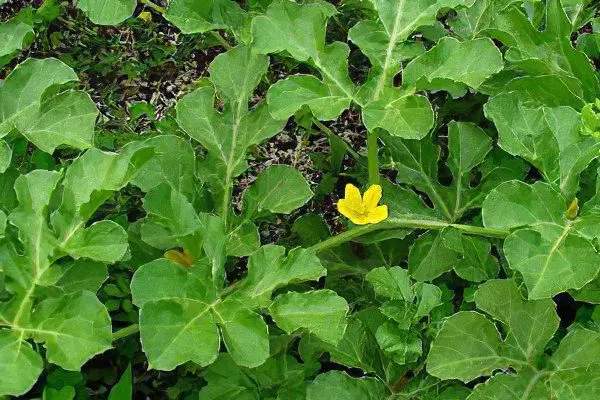Contents
Useful properties and uses of colocynth
Description of the colocynth

Colocynth is an unusual creeping plant with a fleshy thick root. Such a rough perennial has relatively thin angular-furrowed stems, the diameter of which does not exceed 3 mm. The length of the open, strongly branched stems of the stiff-haired type is approximately one and a half meters. The size of the next petiolate leaves varies from 5 to 12 cm.
They are dark green above and ash gray below. On both sides, each leafy, deeply pinnately divided plate is pubescent with simple glandular hairs. The leaves have several notched lobes. All terminal lobes are strongly elongated. The length of the leaf petioles is from 1 to 5 cm. Such a monoecious plant boasts beautiful single flowers located on heavily pubescent short pedicels. The round-elliptical pistil has a three-celled shape and a pubescent ovary.
The perianth has an interpetal appearance, and the pubescent five-lobed calyx has a lanceolate pointed shape. The yellow five-part corolla is endowed with blunt ovoid lobes. All staminate flowers are located at the bottom of a small stem. They have 5 stamens, four of which are fused in pairs. In addition, winding anthers can be noted. Amazing pistillate flowers, visible at the top of a thin stem, have three staminodes and one small pistil.
The pubescent naked fruit of the colocynth at the very beginning has a light green tint. As it matures, it turns yellow. A spherical multi-seeded fruit in diameter reaches 10 cm. It has a thin leathery outer part of the pericarp. As a rule, the spongy bitter flesh of the fruit itself is slightly yellowish or almost white. When dry, it is somewhat spongy and easily breaks into three parts.
Oblong-ovoid seeds are always smooth and flat. Their length does not exceed 7 mm. The shade of seeds can vary from greenish yellow to dark brown. This plant usually blooms in August and September, and the colocynth does not bear fruit until September. North Africa is considered its homeland. To date, the plant can be found in India, Turkmenistan and Western Asia. It prefers sandy dry steppes and semi-deserts. Easily bred in Transcaucasia and Central Asia. Reproduction is carried out only by seeds.
Useful properties of colocynth
The main active ingredient of the coloncinte is the glycoside cucurbitacin. This substance is considered carcinogenic. Resins, essential oils, fatty oils and other no less healing trace elements have a powerful laxative effect on the human body. The fruits of the plant contain a-spinosterol, a-elatherin, citrullol phytosterolin, as well as colocynthine glucoside and essential oil. In the seeds, the content of fatty oil exceeds more than 23%.
The roots are rich in alkaloids and glycosides, saponins and resins, there is also a-elatherin, the hydrocarbon gentriacontan and the glycoside cucurbitacin. In medicine, the fruits of the plant are often used. Of no small importance is an excellent homeopathic preparation based on coloncinte. This multicomponent medicine has an excellent anti-inflammatory and choleretic effect, and also boasts an antispasmodic effect.
Due to the optimal combination of various components, the drug has a laxative effect. In addition, these homeopathic granules are a wonderful liver stimulant. This effect of the fruit is primarily due to the contained glycosides.
The use of colocynth

Various colocynth-based agents are indicated as mild laxatives. All kinds of pills, powders, tinctures and extracts are used, which are rich in healing trace elements. Special homeopathic granules are prescribed mainly for severe stomach cramps and colic. They are also indicated for chronic gastroduodenitis, gastritis and non-ulcer functional dyspepsia. In the form of a liver stimulant, it is recommended to use special powders from colocynth.
It should also be mentioned that the allopathic use of the plant is due to its incomparable laxative properties. For self-preparation of the drug, it is recommended to collect ripened fruits, which should then be well cleaned of the yellow peel and dried thoroughly. Such dried peeled fruits will become very light, and their diameter will not exceed 8 cm.
Contraindications colocynth
In fairly large doses, all kinds of preparations from colocynth cause nephritis and cystitis. In addition, various allergic reactions are also possible. During pregnancy, the use of funds based on this plant is possible only if the potential risk to the fetus is less than the expected benefit to the mother of the baby. Children under the age of 12 years, various means are contraindicated. People with diabetes should use any colocynth medications under the strict supervision of a physician.
Side effects can be acute pain in the intestines and severe inflammation. If side effects occur, treatment with drugs is recommended to be stopped immediately.









